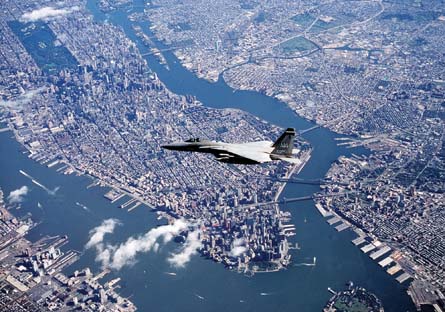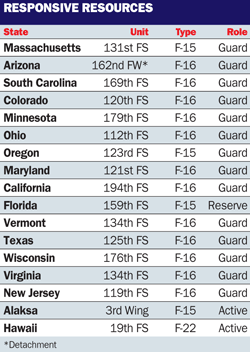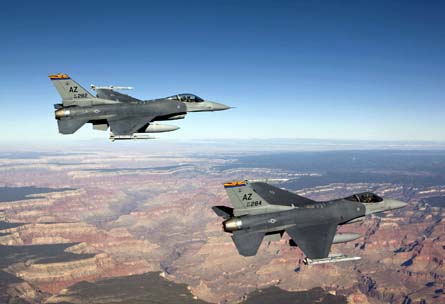The air superiority alert mission is the single function of most of the world's air forces, but in the US Air Force its importance has fluctuated with history.
At its Cold War peak in 1958, the USAF kept some 5,800 aircraft on full alert. The worry then was a phalanx of Soviet bombers laden with nuclear weapons pouring over the Canadian and Alaskan Arctic. It was a mission that demanded its own fleet of specialised interceptors, such as the Convair F-106 Delta Dart loaded with nuclear-tipped air-to-air missiles.
The end of the Cold War was unkind to the air superiority alert fleet. Already eroded significantly since intercontinental ballistic missiles eclipsed Soviet bombers as the main threat to US security, the mission of intercepting enemy or even suspicious aircraft was allowed to diminish further after the collapse of the Soviet Union.
 |
|---|
© USAFA Boeing F-15 over New york City |
By 1994, the North American Aerospace Defense Command (NORAD) still had full control of more than 10 units with 180 fighters spread over 14 sites around the continent. But that force would be entirely dismantled by 1995. No longer would the USAF dedicate active duty or Air National Guard aircraft and aircrews solely to protecting the national borders. The change was driven not only by budget cutbacks that shrank the size of the USAF fleet from 26.5 to 20 fighter wing equivalents. By the mid-1990s, avionics upgrades to the Boeing F-15 and Lockheed Martin F-16 also enabled these aircraft to perform several missions.
In the latter half of the mid-1990s, the chief focus of the air defence mission was on countering drug smugglers trying to sneak across the borders and the biggest threat was considered to be cruise missiles launched offshore by vessels belonging to so-called rogue states.
When the four hijacked airliners struck three of their intended targets on 11 September a decade ago, NORAD's notheast air defence sector had few options. Two Boeing F-15As standing alert on Cape Cod, Massachusetts, were scrambled, but went airborne only after American Airlines Flight 11 crashed into the North Tower of the World Trade Center in New York. Two Lockheed Martin F-16s also were scrambled from Langley AFB, Virginia, but arrived over Washington DC, to find smoke rising from the Pentagon.
Only four fighters stood armed and fuelled on alert on the East Coast to intercept the hijacked airliners. The attacks exposed a critical weakness in the country's air defence, and the USAF duly took notice.
Ten years later, the USAF's ability to respond to a similar attack would be much stronger. The eastern USA now has units on alert on five bases stretching from Atlantic City, New Jersey, to Miami. A further five units stand watch on approaches from the Pacific, including Alaska and Hawaii, and eight other units dot the northern and southern borders. The Air National Guard has nearly 1,100 personnel assigned to support the air sovereignty alert mission. The units are not dedicated to NORAD and are expected to take part in the USAF's cyclical deployment cycle, but they remain very busy in the air sovereignty role.
 |
|---|
As of 12 August, Operational Noble Eagle had accumulated 59,703 sorties flown since the 11 September terrorist attacks nearly a decade earlier. The sorties included 42,050 flights by fighters, 11,342 by tankers and 1,572 by the Boeing E-3A airborne warning and control system. The total also includes patrol missions flown around Washington DC by helicopters operated by the US Coast Guard and fixed-wing flights by the Civil Air Patrol.
The force is stronger and more organised than it was 10 years ago and perhaps even in 1994 before NORAD's fighters were retired or dispersed.
But the process of creating the new structure provoked several major concerns, including some that remain unanswered.
The Air National Guard now operates units at 16 of the 18 alert sites. For most of the past 10 years, the USAF did not include alert operations in long-term budget plans, so full-time staff dedicated to that mission operated on two-year budget cycles. The uncertainty caused many pilots and maintenance staff to seek jobs elsewhere, according to a 2009 report by the Government Accountability Office.
Perhaps of greater concern has been the status of the Air National Guard's fighters assigned to the air sovereignty alert mission. On the two alert bases controlled by active duty units in Alaska and Hawaii, the USAF could summon the F-22A until it was grounded earlier this year, with later-model Boeing F-15C/Ds serving as capable back-up. The Air National Guard has fewer and less desirable options. Five of its alert units operate F-15s, but 11 others operate some of the Guard's oldest F-16s.
Several members of Congress, led by Representatives Frank Lobiondo and Gabrielle Giffords, began expressing grave concerns about the future of the air sovereignty alert mission with such an ageing force structure. Giffords is still recovering from a bullet wound she suffered on 8 January. Before the attack, one of her main causes was to call attention to this issue.
 |
|---|
© Arizona Air National GuardF-16s over the Grand Canyon |
The Air National Guard warned Congress last year that its biggest concern was recapitalising the F-16 fleet. At that time, 80% of the Air National Guard's F-16s that perform the alert mission were programmed to be retired by FY2017. These F-16s are the oldest models still in US service, including Block 25s, Block 30s and Block 32s.
The potential "fighter gap" has been exacerbated by delays in the acquisition of the Lockheed F-35A. The Air National Guard is not programmed to receive its first F-35A until active duty units stand up three operational wings of 72 aircraft each, and the in-service date for the type has been delayed beyond FY2016.
The USAF appears to have partially addressed the Air National Guard's worst concerns. In late 2010, top USAF officials disclosed plans to launch a structural upgrade programme. A few months later, in January, the Air National Guard reported to Congress that nine of the 11 units with the oldest F-16s would be preserved for five more years, pushing the retirement to between 2018 and 2020. The status of the other two F-16 units is not clear. The USAF has the option to double-task two other Air National Guard or active duty units with the air sovereignty alert mission.
Source: Flight International



















